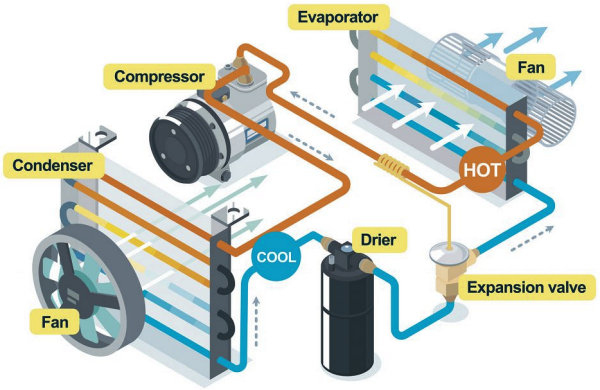Mobile Automotive Air Conditioning Repair
Air conditioners are one of the least reliable automobile systems. They often leak the high pressure gas (refrigerant commonly called Freon) which may lead to failure of the compressor, an expensive part. If you notice your air conditioner not getting as cold as it used to, it's best to get it checked for leaks and recharged with refrigerant. Like most other auto maintenance, tackling small repairs can prevent much more expensive major repairs.
A/C Compressor
An AC compressor runs off a pulley that's attached via a belt to the crankshaft of your engine. This powers 5-10 pistons (depending on the design). They suck in low-pressure, low-temperature gas and compress it into high-pressure, high-temperature gas.
Replace A/C Compressor - Starting at $150 plus parts.
Condenser

By the time the refrigerant reaches the condenser, it is hot due to being pressurized. Its job is to capture this heat and transfer it out of the AC system. You can think of this part as a mini radiator, and as the gas passes through it, it radiates the heat outwards.
Air is also flowing around the condenser, which in turn cools the refrigerant as it's passing through. This causes it to condense, which turns it back into a high-pressure liquid with a lower temperature.
A/C Condenser Service - Starting at $150 plus parts.
Expansion Valve
An expansion valve is basically a controller for how much refrigerant is allowed to continue on through the AC system. You can think of it as similar to the nozzle on the end of a hose, high-pressure water is introduced, and it expands into a mist as it passes through.
By this point, the refrigerant is now in a low-pressure, low-temperature state, nearly ready to cool your passenger cabin. But first, it has to pass through the evaporator.
Evaporator
The evaporator works much like a radiator or a condenser, containing lines that the refrigerant flows through. As this happens, rather than dissipating heat, it absorbs it, lowering the temperature to about 32 degrees.
Oddly enough, unlike water, which freezes at 32 degrees, the refrigerant boils. This converts it back into a gaseous state, allowing it to absorb even more heat. This gas then flows back into the AC compressor to start the process over again.
While the refrigerant is sitting in the evaporator, a fan is blowing outside air over it. This causes it to cool due to the low temperature inside. This air then enters your cabin as a cold, refreshing, air-conditioned breeze.
Air Conditioner Diagnostic Fee - $75.
Recharge Air Conditioning System - $100.

Keller, Texas
Keller is mostly residential, featuring more than 300 acres of developed land for 11 park sites and more than 26 miles of hiking and biking trails. The city prides itself as "Texas's Most Family Friendly City."

 817-204-6283
817-204-6283